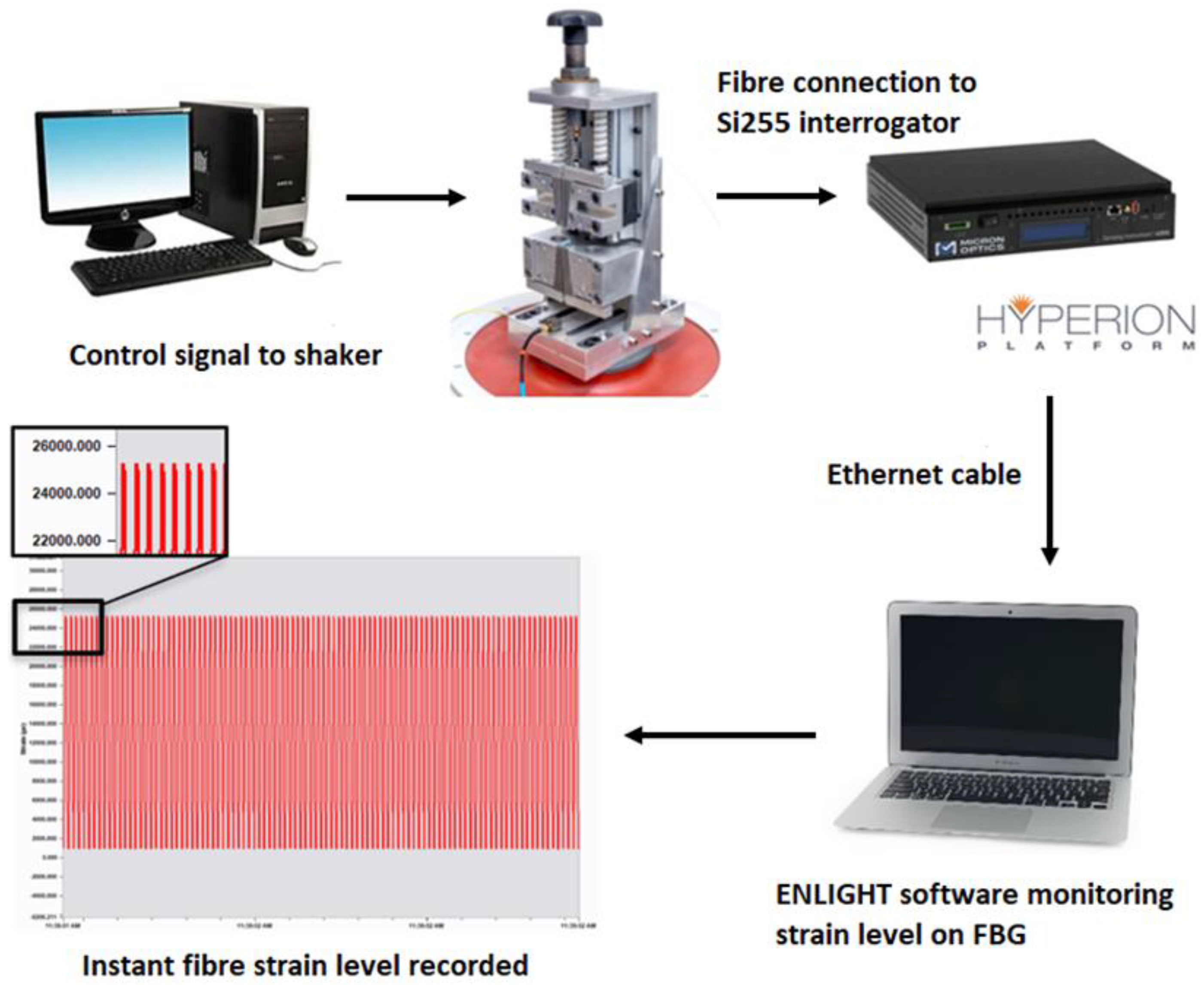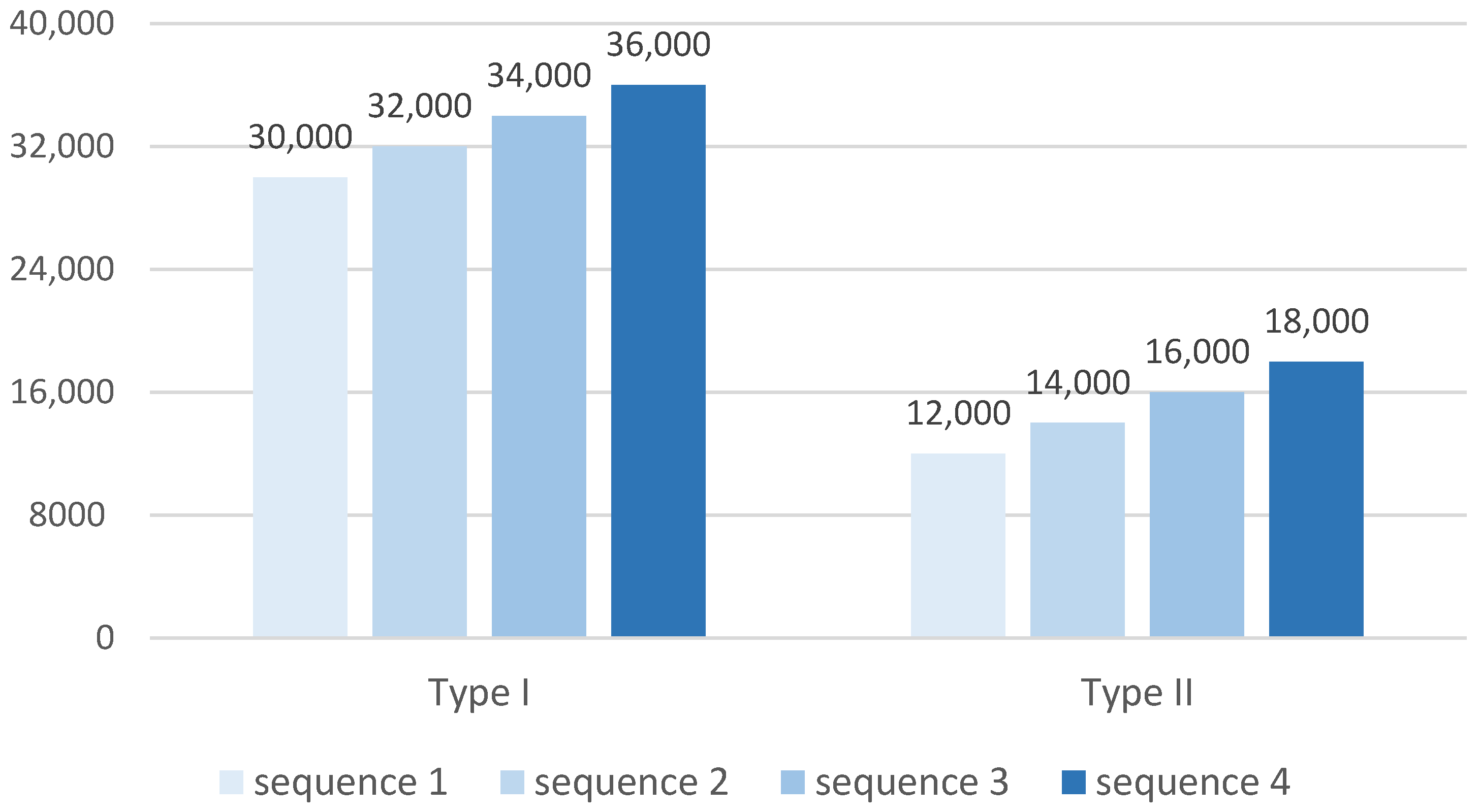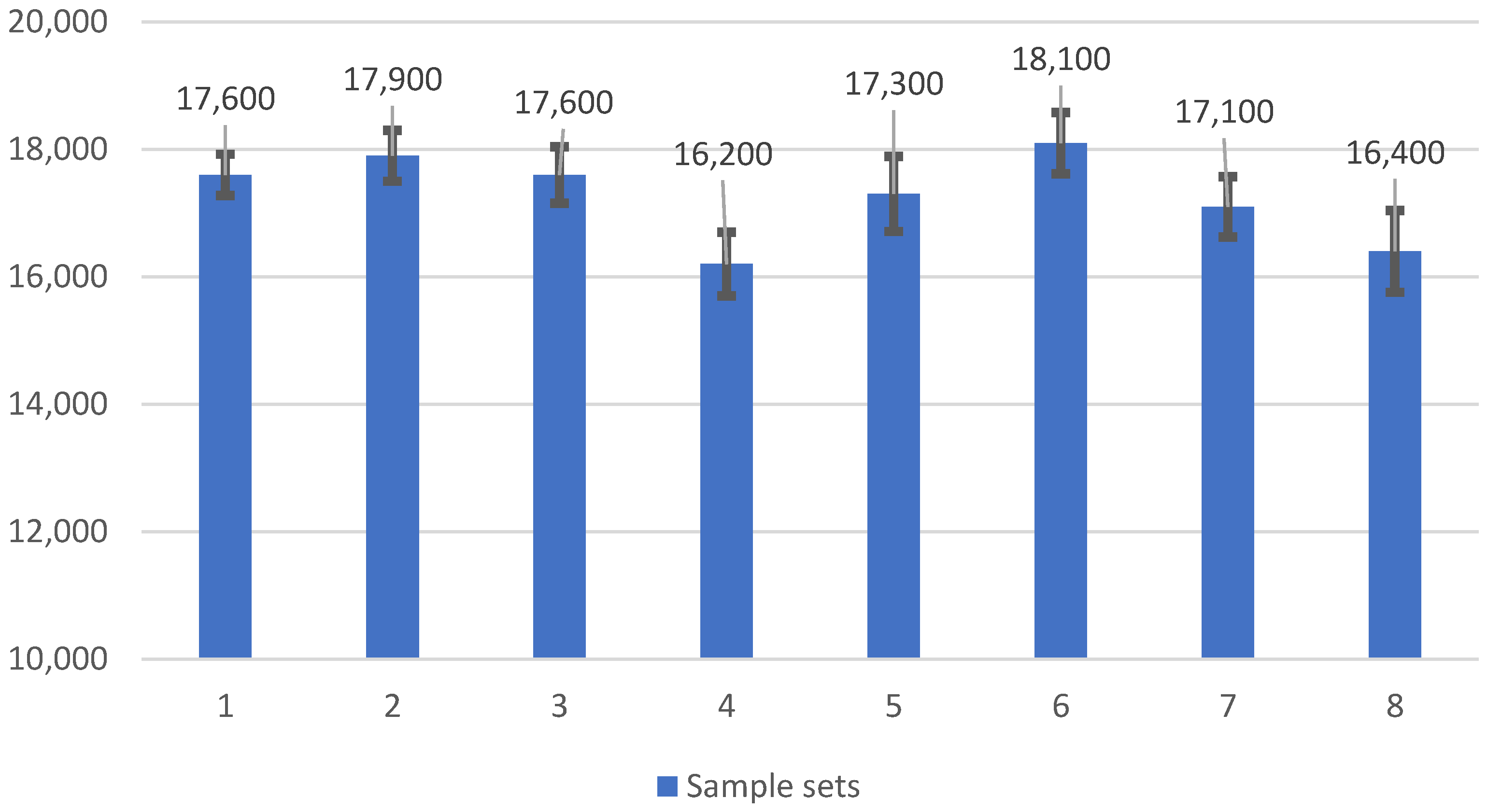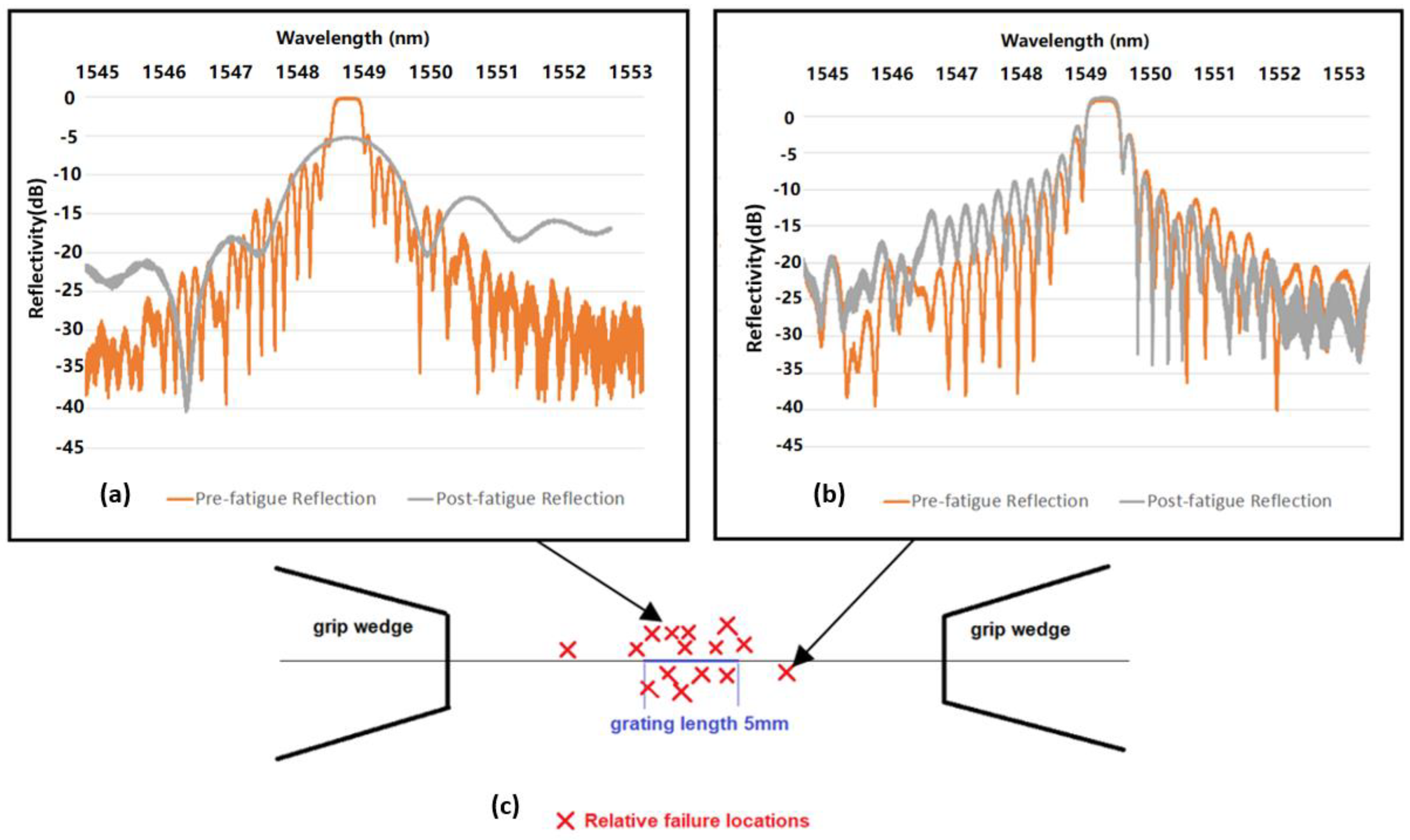Fatigue Performance of Type I and Type II Fibre Bragg Gratings Fabricated by Femtosecond Laser Inscription through the Coating
Abstract
1. Introduction
- Fs-IR pulses facilitate writing through the coating because most polymers are IR transparent [33,34]. The FBGs written through the coating are also known as trans-jacket or trans-coating FBGs. With no requirement to strip the fibre before laser exposure, the manufacturing process is much simpler and lends itself more readily to automation, reducing unit cost and increasing sensor reliability and durability.
- Type II gratings inscribed using fs-IR pulses have similar properties to Type II UV-inscribed gratings regarding thermal stability, but much higher index modulation and superior spectral quality [16].
- High index modulation can be achieved by IR laser exposure without special photosensitisation of the fibre, such as hydrogen loading or special core doping with photosensitive materials.
1.1. FBG Working Principles
1.2. Type I and Type II Characterisations of IR Laser-Induced FBG Sensors
2. Experimental Methods
2.1. Microscopic Analysis of the Fibre Surface
2.2. Spectral Analysis of FBG Reflective and Transmissive Properties
2.3. Test Matrix and Fatigue Load
3. Results and Discussion
3.1. Microscopic Inspection of the FBG Sensor Region
3.2. The Pre- and Post-Fatigue Reflection Spectra Analysis
4. Conclusions
- Type I trans-jacket FBGs written using fs-IR laser with active core alignment have high cyclic failure strain (above 36,000 µε) and fatigue life. Although Type II trans-jacket FBGs have a lower mean failure strain of approximately 17,000 µε, they can withstand more than one million cyclic load applications at 15,000 µε. Since aerospace structures seldom experience strains above 10,000 µε, even under extreme operational conditions, Type II trans-jacket FBGs written using the customised fs-IR grating inscription technique [40] have strong potential for long-term strain monitoring applications in aircraft and other high value engineering structures, particularly in high temperature environments where Type I gratings might be prone to erasure.
- Type II trans-jacket FBGs are prone to breaking at the grating under quasi-static and cyclic loading, confirming the hypothesis that the damage inscription process creates weakness in the optical fibres leading to degradation of their fatigue performance.
- The photosensitisation approach and fibre geometry had no significant impact on the mechanical fatigue performance of Type I and Type II gratings.
Author Contributions
Funding
Institutional Review Board Statement
Informed Consent Statement
Data Availability Statement
Acknowledgments
Conflicts of Interest
References
- Hill, K.O.; Fujii, Y.; Johnson, D.C.; Kawasaki, B.S. Photosensitivity in optical fiber waveguides: Application to reflection filter fabrication. Appl. Phys. Lett. 1978, 32, 647–649. [Google Scholar] [CrossRef]
- Majumder, M.; Gangopadhyay, T.K.; Chakraborty, A.K.; Dasgupta, K.; Bhattacharya, D.K. Fibre Bragg gratings in structural health monitoring—Present status and applications. Sens. Actuators A Phys. 2008, 147, 150–164. [Google Scholar] [CrossRef]
- Yoon, H.-J.; Costantini, D.M.; Michaud, V.; Limberger, H.G.; Manson, J.-A.; Salathe, R.P.; Kim, C.-G.; Hong, C.-S. In situ simultaneous strain and temperature measurement of adaptive composite materials using a fiber Bragg grating based sensor. In Proceedings of the Smart Structures and Materials 2005: Smart Sensor Technology and Measurement Systems, San Diego, CA, USA, 7–10 March 2005; Volume 5758, pp. 62–69. [Google Scholar] [CrossRef]
- Meltz, G.; Morey, W.W.; Glenn, W.H.; Farina, J.D. In-Fiber Bragg-Grating Sensors; Optical Fiber Sensors: New Orleans, LA, USA, 1988. [Google Scholar] [CrossRef]
- Kersey, A.D.; Davis, M.A.; Patrick, H.J.; LeBlanc, M.; Koo, K.P.; Askins, C.G.; Putnam, M.A.; Friebele, E.J. Fiber grating sensors. J. Light. Technol. 1997, 15, 1442–1462. [Google Scholar] [CrossRef]
- Di Sante, R. Fibre optic sensors for structural health monitoring of aircraft composite structures: Recent advances and applications. Sensors 2015, 15, 18666–18713. [Google Scholar] [CrossRef]
- Ramly, R.; Kuntjoro, W.; Rahman, M.K.A. Using embedded fiber bragg grating (FBG) sensors in smart aircraft structure materials. Procedia Eng. 2012, 41, 600–606. [Google Scholar] [CrossRef]
- Dewynter-Marty, V.; Ferdinand, P.; Bocherens, E.; Carbone, R.; Beranger, H.; Bourasseau, S.; Dupont, M.; Balageas, D. Embedded Fiber Bragg Grating sensors for industrial composite cure monitoring. J. Intell. Mater. Syst. Struct. 1998, 9, 785–787. [Google Scholar] [CrossRef]
- Richards, W.L.; Parker, A.R.; Ko, W.L.; Piazza, A.; Chan, P. Application of Fiber Optic Instrumentation; BiblioGov: Warsaw, Poland, 2012; Volume 22. [Google Scholar]
- Nicolas, M.J.; Sullivan, R.W.; Richards, W.L. Large scale applications using FBG sensors: Determination of in-flight loads and shape of a composite aircraft wing. Aerospace 2016, 3, 18. [Google Scholar] [CrossRef]
- Davis, C.; Tejedor, S.; Grabovac, I.; Kopczyk, J.; Nuyens, T. High-strain fiber bragg gratings for structural fatigue testing of military aircraft. Photonic Sens. 2012, 2, 215–224. [Google Scholar] [CrossRef]
- Rothhardt, M.W.; Chojetzki, C.; Mueller, H.R. High-mechanical-strength single-pulse draw tower gratings. In Proceedings of the Photonics North 2004: Photonic Applications in Telecommunications, Sensors, Software, and Lasers, Ottawa, ON, Canada, 26–29 September 2004. [Google Scholar] [CrossRef]
- Meltz, G.; Morey, W.W.; Glenn, W.H. Formation of Bragg gratings in optical fibers by a transverse holographic method. Opt. Lett. 1989, 14, 823–825. [Google Scholar] [CrossRef]
- Lancry, M.; Poumellec, B. UV laser processing and multiphoton absorption processes in optical telecommunication fiber materials. Phys. Rep. 2013, 523, 207–229. [Google Scholar] [CrossRef]
- Davis, K.M.; Miura, K.; Sugimoto, N.; Hirao, K. Writing waveguides in glass with a femtosecond laser. Opt. Lett. 1996, 21, 1729–1731. [Google Scholar] [CrossRef] [PubMed]
- Mihailov, S.J.; Smelser, C.W.; Grobnic, D.; Walker, R.B.; Lu, P.; Ding, H.; Unruh, J. Bragg Gratings Written in All-SiO2 and Ge-Doped Core Fibers with 800-nm Femtosecond Radiation and a Phase Mask. J. Light. Technol. 2004, 22, 94–100. [Google Scholar] [CrossRef]
- Albert, J.; Malo, B.; Hill, K.O.; Bilodeau, F.; Johnson, D.C.; Thériault, S. Comparison of one-photon and two-photon effects in the photosensitivity of germanium-doped silica optical fibers exposed to intense ArF excimer laser pulses. Appl. Phys. Lett. 1995, 67, 3529–3531. [Google Scholar] [CrossRef]
- Seward, T.P.; Smith, C.; Borrelli, N.F.; Allan, D.C. Densification of synthetic fused silica under ultraviolet irradiation. J. Non-Cryst. Solids 1997, 222, 407–414. [Google Scholar] [CrossRef]
- Nikogosyan, D.N. Multi-photon high-excitation-energy approach to fibre grating inscription. Meas. Sci. Technol. 2007, 18, R1. [Google Scholar] [CrossRef]
- Ang, J.; Li, H.C.H.; Herszberg, I.; Bannister, M.K.; Mouritz, A.P. Tensile fatigue properties of fibre Bragg grating optical fibre sensors. Int. J. Fatigue 2010, 32, 762–768. [Google Scholar] [CrossRef]
- Yoon, H.J.; Kim, C.G. The mechanical strength of fiber Bragg gratings under controlled UV laser conditions. Smart Mater. Struct. 2007, 16, 1315. [Google Scholar] [CrossRef]
- Espindola, R.P.; Atkins, R.M.; Wang, N.P.; Simoff, D.A.; Paczkowski, M.A.; Windeler, R.S.; Brownlow, D.L.; Shenk, D.S.; Glodis, P.A.; Strasser, T.A.; et al. Highly reflective fiber Bragg gratings written through a vinyl ether fiber coating. IEEE Photonics Technol. Lett. 1999, 11, 833–835. [Google Scholar] [CrossRef]
- Starodubov, D.S.; Grubsky, V.; Feinberg, J. Efficient Bragg grating fabrication in a fibre through its polymer jacket using near-UV light. Electron. Lett. 1997, 33, 1331–1333. [Google Scholar] [CrossRef]
- Douay, M.; Xie, W.X.; Taunay, T.; Bernage, P.; Niay, P.; Cordier, P.; Poumellec, B.; Dong, L.; Bayon, J.F.; Poignant, H.; et al. Densification involved in the UV-based photosensitivity of silica glasses and optical fibers. J. Light. Technol. 1997, 15, 1329–1342. [Google Scholar] [CrossRef]
- Askins, C.G.; Putnam, M.A.; Williams, G.M.; Friebele, E.J. Stepped-wavelength optical-fiber Bragg grating arrays fabricated in line on a draw tower. Opt. Lett. 1994, 19, 147–149. [Google Scholar] [CrossRef] [PubMed]
- Askins, C.G.; Putnam, M.A.; Patrick, H.J.; Friebele, E.J. Fibre strength unaffected by on-line writing of single-pulse Bragg gratings. Electron. Lett. 1997, 33, 1333–1334. [Google Scholar] [CrossRef]
- Askins, C.G.; Tsai, T.-E.; Williams, G.M.; Putnam, M.A.; Bashkansky, M.; Friebele, E.J. Fiber Bragg reflectors prepared by a single excimer pulse. Opt. Lett. 1992, 17, 833–835. [Google Scholar] [CrossRef]
- Kashyap, R. Fiber Bragg Gratings; Academic Press: Cambridge, MA, USA, 2010; ISBN 9780123725790. [Google Scholar]
- Grobnic, D.; Smelser, C.W.; Mihailov, S.J.; Walker, R.B.; Lu, P. Fiber Bragg gratings with suppressed cladding modes made in SMF-28 with a femtosecond IR laser and a phase mask. IEEE Photonics Technol. Lett. 2004, 16, 1864–1866. [Google Scholar] [CrossRef]
- Martinez, A.; Dubov, M.; Khrushchev, I.; Bennion, I. Point by point FBG Inscription by a focused NIR femtosecond laser. In Proceedings of the OSA Trends in Optics and Photonics Series, San Francisco, CA, USA, 16–21 May 2004; Volume 96 A. [Google Scholar]
- Martinez, A.; Khrushchev, I.Y.; Bennion, I. Direct inscription of Bragg gratings in coated fibers by an infrared femtosecond laser. Opt. Lett. 2006, 31, 1603–1605. [Google Scholar] [CrossRef]
- Grobnic, D.; Mihailov, S.J.; Smelser, C.W.; Ramos, R.T. Ultrafast IR laser writing of strong Bragg gratings through the coating of high Ge-doped optical fibers. IEEE Photonics Technol. Lett. 2008, 20, 973–975. [Google Scholar] [CrossRef]
- Martinez, A.; Dubov, M.; Khrushchev, I.; Bennion, I. Photoinduced modifications in fiber gratings inscribed directly by infrared femtosecond irradiation. IEEE Photonics Technol. Lett. 2006, 18, 2266–2268. [Google Scholar] [CrossRef]
- Albert, J.; Fokine, M.; Margulis, W. Grating formation in pure silica-core fibers. Opt. Lett. 2002, 27, 809–811. [Google Scholar] [CrossRef]
- Cook, K.; Canning, J.; Pohl, A.A.P.; Holdsworth, J.; Stevenson, M.; Bandyopadhyay, S.; Groothoff, N. Bragg grating writing in photonic crystal fibres. In Proceedings of the Photonic Crystal Fibers III, Prague, Czech Republic, 20–23 April 2009; Volume 7357. [Google Scholar] [CrossRef]
- Bernier, M.; Faucher, D.; Vallée, R.; Saliminia, A.; Androz, G.; Sheng, Y.; Chin, S.L. Bragg gratings photoinduced in ZBLAN fibers by femtosecond pulses at 800 nm. Opt. Lett. 2007, 32, 454–456. [Google Scholar] [CrossRef]
- Zhang, N.; Davis, C.; Chiu, W.K.; Boilard, T.; Bernier, M. Fatigue performance of type I fibre bragg grating strain sensors. Sensors 2019, 19, 3524. [Google Scholar] [CrossRef]
- Bernier, M.; Trépanier, F.; Carrier, J.; Vallée, R. High mechanical strength fiber Bragg gratings made with infrared femtosecond pulses and a phase mask. Opt. Lett. 2014, 39, 3646. [Google Scholar] [CrossRef] [PubMed]
- Mihailov, S.J. Fiber bragg grating sensors for harsh environments. Sensors 2012, 12, 1898–1918. [Google Scholar] [CrossRef] [PubMed]
- Grobnic, D.; Smelser, C.W.; Mihailov, S.J.; Walker, R.B. Long-term thermal stability tests at 1000 °C of silica fibre Bragg gratings made with ultrafast laser radiation. Meas. Sci. Technol. 2006, 17, 1009. [Google Scholar] [CrossRef]
- Martinez, A.; Khrushchev, I.Y.; Bennion, I. Thermal properties of fibre Bragg gratings inscribed point-by-point by infrared femtosecond laser. Electron. Lett. 2005, 41, 176–178. [Google Scholar] [CrossRef]
- Smelser, C.W.; Mihailov, S.J.; Grobnic, D. Formation of Type I-IR and Type II-IR gratings with an ultrafast IR laser and a phase mask. Opt. Express 2005, 13, 5377. [Google Scholar] [CrossRef] [PubMed]
- Sudrie, L.; Franco, M.; Prade, B.; Mysyrowicz, A. Study of damage in fused silica induced by ultra-short IR laser pulses. Opt. Commun. 2001, 191, 333–339. [Google Scholar] [CrossRef]
- Habel, J.; Boilard, T.; Frenière, J.S.; Trépanier, F.; Bernier, M. Femtosecond FBG written through the coating for sensing applications. Sensors 2017, 17, 2519. [Google Scholar] [CrossRef]
- Wei, C.Y.; Ye, C.C.; James, S.W.; Tatam, R.P.; Irving, P.E. The influence of hydrogen loading and the fabrication process on the mechanical strength of optical fibre Bragg gratings. Opt. Mater. (Amst.) 2002, 20, 241–251. [Google Scholar] [CrossRef][Green Version]
- Campanella, C.E.; Cuccovillo, A.; Campanella, C.; Yurt, A.; Passaro, V.M.N. Fibre Bragg Grating based strain sensors: Review of technology and applications. Sensors 2018, 18, 3115. [Google Scholar] [CrossRef]
- Frazão, O.; Carvalho, J.P.; Ferreira, L.A.; Araújo, F.M.; Santos, J.L. Discrimination of strain and temperature using Bragg gratings in microstructured and standard optical fibres. Meas. Sci. Technol. 2005, 16, 2109. [Google Scholar] [CrossRef]
- Xu, M.G.; Archambault, J.L.; Reekie, L.; Dakin, J.P. Discrimination between strain and temperature effects using dual-wavelength fibre grating sensors. Electron. Lett. 1994, 30, 1085–1087. [Google Scholar] [CrossRef]
- Chehura, E.; James, S.W.; Tatam, R.P. Temperature and strain discrimination using a single tilted fibre Bragg grating. Opt. Commun. 2007, 275, 344–347. [Google Scholar] [CrossRef]
- Nolte, S.; Will, M.; Burghoff, J.; Tuennermann, A. Femtosecond waveguide writing: A new avenue to three-dimensional integrated optics. Appl. Phys. A 2003, 77, 109–111. [Google Scholar] [CrossRef]
- Couairon, A.; Sudrie, L.; Franco, M.; Prade, B.; Mysyrowicz, A. Filamentation and damage in fused silica induced by tightly focused femtosecond laser pulses. Phys. Rev. B—Condens. Matter Mater. Phys. 2005, 71, 125435. [Google Scholar] [CrossRef]
- Sudrie, L.; Couairon, A.; Franco, M.; Lamouroux, B.; Prade, B.; Tzortzakis, S.; Mysyrowicz, A. Femtosecond Laser-Induced Damage and Filamentary Propagation in Fused Silica. Phys. Rev. Lett. 2002, 89, 186601. [Google Scholar] [CrossRef]
- Martinez, A.; Dubov, M.; Khrushchev, I.; Bennion, I. Direct writing of fibre Bragg gratings by femtosecond laser. Electron. Lett. 2004, 40, 1. [Google Scholar] [CrossRef]
- Sudrie, L.; Franco, M.; Prade, B.; Mysyrowicz, A. Writing of permanent birefringent microlayers in bulk fused silica with femtosecond laser pulses. Opt. Commun. 1999, 171, 279–284. [Google Scholar] [CrossRef]
- Glezer, E.N.; Mazur, E. Ultrafast-laser driven micro-explosions in transparent materials. Appl. Phys. Lett. 1997, 71, 882–884. [Google Scholar] [CrossRef]
- Archambault, J.L.; Reekie, L.; Russell, P.S.J. 100% reflectivity bragg reflectors produced in optical fibres by single excimer laser pulses. Electron. Lett. 1993, 29, 453–455. [Google Scholar] [CrossRef]
- Grobnic, D.; Mihailov, S.J.; Ballato, J.; Dragic, P.D. Type I and II Bragg gratings made with infrared femtosecond radiation in high and low alumina content aluminosilicate optical fibers. Optica 2015, 2, 313–322. [Google Scholar] [CrossRef]
- McJunkins, S.P.; Thornton, J.I. Glass fracture analysis. A review. Forensic Sci. 1973, 2, 1–27. [Google Scholar] [CrossRef]
- Abdullina, S.R.; Vlasov, A.A. Suppression of side lobes in the fiber Bragg grating reflection spectrum. Optoelectron. Instrum. Data Process. 2014, 50, 75–86. [Google Scholar] [CrossRef]
- HBM. The Fatigue Life of Electrical Strain Gauges. 2020. Available online: https://www.hbm.com/en/8153/new-technote-fatigue-life-of-electrical-strain-gauges/ (accessed on 27 October 2020).





| Optical Fibre | Deuterium Loaded | Core (Clad) Diameter, µm | Numerical Aperture (Nominal) | Germanium Dopant |
|---|---|---|---|---|
| OFS: ClearLite POLY (4.6/125, 0.21NA) | Y&N | 4.6 (125 ± 2) | 0.21 | ~10 mol% |
| OFS: ClearLite POLY (8.4/125, 0.11NA) | Y&N | 8.4 (125 ± 2) | 0.11 | ~3 mol% |
| Fibercore: SM1500 (4.2/80)P | Y&N | 4.2 (80) | 0.29–0.31 | ~20 mol% |
| Fibercore: SM1500 (9/125)P | Y&N | 9 (80) | 0.29–0.31 | ~3 mol% |
| Type of Inscription | Type I | Type II | ||||||
|---|---|---|---|---|---|---|---|---|
| Peak Strain (µε) | 30,000 | 32,000 | 34,000 | 36,000 | 12,000 | 14,000 | 16,000 | 18,000 |
| Load Cycles (million) | 0.5 | 0.5 | 0.5 | 0.5 | 0.5 | 0.5 | 0.5 | 0.5 |
| Fibre Tested | Deuterium Loaded | Specimens Tested | Fatigue Results |
|---|---|---|---|
| OFS BF04446, ClearLite POLY (8.4/125, 0.11NA) | Y | 15 | Survived 2 million load cycle applications without breaking |
| OFS BF04446, ClearLite POLY (8.4/125, 0.11NA) | N | 15 | Survived 2 million load cycle applications without breaking |
| OFS BF06160-02, ClearLite POLY (4.6/125, 0.21NA) | Y | 5 | Survived 2 million load cycle applications without breaking |
| OFS BF06160-02, ClearLite POLY (4.6/125, 0.21NA) | N | 5 | Survived 2 million load cycle applications without breaking |
| FibreCore: SM1500 (4.2/80)P | Y | 15 | Survived 2 million load cycle applications without breaking |
| FibreCore: SM1500 (4.2/80)P | N | 15 | Survived 2 million load cycle applications without breaking |
| Fibercore: SM1500 (9/125)P | Y | 5 | Survived 2 million load cycle applications without breaking |
| Fibercore: SM1500 (9/125)P | N | 5 | Survived 2 million load cycle applications without breaking |
| Sample Set | Fibre Type | Deuterium Loaded | Specimens Tested | Mean Failure Strain, µε | 95% Confidence Interval |
|---|---|---|---|---|---|
| 1 | OFS BF04446, ClearLite POLY (8.4/125, 0.11NA) | Y | 15 | 17,600 | ±324 |
| 2 | OFS BF04446, ClearLite POLY (8.4/125, 0.11NA) | N | 15 | 17,900 | ±400 |
| 3 | OFS BF06160-02, ClearLite POLY (4.6/125, 0.21NA) | Y | 5 | 17,600 | ±445 |
| 4 | OFS BF06160-02, ClearLite POLY (4.6/125, 0.21NA) | N | 5 | 16,200 | ±500 |
| 5 | FibreCore: SM1500 (4.2/80)P | Y | 15 | 17,300 | ±588 |
| 6 | FibreCore: SM1500 (4.2/80)P | N | 15 | 18,100 | ±480 |
| 7 | Fibercore: SM1500 (9/125)P | Y | 5 | 17,100 | ±473 |
| 8 | Fibercore: SM1500 (9/125)P | N | 5 | 16,400 | ±643 |
Publisher’s Note: MDPI stays neutral with regard to jurisdictional claims in published maps and institutional affiliations. |
© 2022 by the authors. Licensee MDPI, Basel, Switzerland. This article is an open access article distributed under the terms and conditions of the Creative Commons Attribution (CC BY) license (https://creativecommons.org/licenses/by/4.0/).
Share and Cite
Zhang, N.; Turk, S.; Davis, C.; Chiu, W.K.; Boilard, T.; Bernier, M. Fatigue Performance of Type I and Type II Fibre Bragg Gratings Fabricated by Femtosecond Laser Inscription through the Coating. Sensors 2022, 22, 8812. https://doi.org/10.3390/s22228812
Zhang N, Turk S, Davis C, Chiu WK, Boilard T, Bernier M. Fatigue Performance of Type I and Type II Fibre Bragg Gratings Fabricated by Femtosecond Laser Inscription through the Coating. Sensors. 2022; 22(22):8812. https://doi.org/10.3390/s22228812
Chicago/Turabian StyleZhang, Naizhong, Suzana Turk, Claire Davis, Wing K. Chiu, Tommy Boilard, and Martin Bernier. 2022. "Fatigue Performance of Type I and Type II Fibre Bragg Gratings Fabricated by Femtosecond Laser Inscription through the Coating" Sensors 22, no. 22: 8812. https://doi.org/10.3390/s22228812
APA StyleZhang, N., Turk, S., Davis, C., Chiu, W. K., Boilard, T., & Bernier, M. (2022). Fatigue Performance of Type I and Type II Fibre Bragg Gratings Fabricated by Femtosecond Laser Inscription through the Coating. Sensors, 22(22), 8812. https://doi.org/10.3390/s22228812







